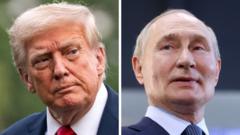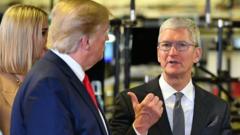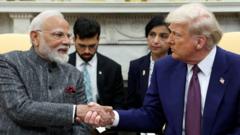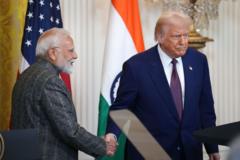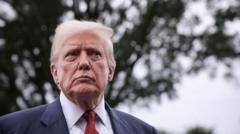A recent analysis shows that under President Trump, Russian assaults on Ukraine have more than doubled, complicating claims of a potential ceasefire. Critics argue that Trump's approach may embolden Kremlin aggression, calling for increased U.S. military support to counter escalating attacks.
Escalating Russian Attacks Under Trump's Presidency: A Double-Edged Situation for Ukraine
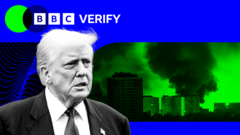
Escalating Russian Attacks Under Trump's Presidency: A Double-Edged Situation for Ukraine
Since President Trump's return to office, missile and drone attacks from Russia have doubled, raising concerns about the impact of U.S. foreign policy and military support for Ukraine.
In an alarming development for Ukraine, the number of Russian drone and missile strikes has more than doubled since Donald Trump resumed the presidency in January. Despite Trump's calls for a rapid ceasefire, a BBC Verify analysis reveals that attacks have intensified markedly since his election victory in November 2023. Aerial assaults commenced a steep rise under former President Joe Biden in 2024, but they reached unprecedented heights following Trump's inauguration.
Trump previously pledged during his campaign to end the fighting in a single day, claiming Russia's invasion could have been avoided with a president the Kremlin "respected." While asserting his commitment to peace, Trump has faced criticism for occasionally appearing to favor Russia. His administration has paused military aid to Ukraine on two separate occasions in March and July, albeit later resuming them, as Russia ramped up its missile and drone manufacturing. Reports from Ukrainian military intelligence indicate a staggering 66% increase in Russian ballistic missile construction over the past year.
According to data compiled by BBC Verify, between January 20 and July 19, Russia launched 27,158 munitions at Ukraine, a sharp uptick from the 11,614 munitions fired in the last six months of Biden's term. White House deputy Press Secretary Anna Kelly attributed the ongoing conflict to Biden's "incompetence," insisting that Trump aims to halt the violence by arming NATO allies and threatening sanctions against Russia if it does not agree to a ceasefire.
Initially, after Trump's inauguration, Russian attacks subsided as the new administration attempted to engage Putin diplomatically. Yet, by February 2024, during talks led by Secretary of State Marco Rubio with Russian officials, assaults rose again, culminating in a significant spike on July 9 when Moscow launched 748 strikes, resulting in casualties.
Despite Trump's expressed frustrations over increasing Russian attacks, it appears his administration's actions have not curtailed Kremlin aggression. Critics, including Senator Chris Coons, suggest that Trump's brief pauses on military aid may have emboldened Putin, enabling intensified assaults on Ukrainian civilians, including strikes on hospitals and energy infrastructure.
In light of the escalating attacks, there are renewed calls for the U.S. to supply advanced military systems, including Patriot batteries, considered essential for Kyiv's air defense. Trump's recent approval of weapon sales to NATO allies presumes that these systems would also reach Ukraine, although analysts warn that ongoing U.S. supply restrictions make Ukraine vulnerable.
Moreover, reports indicate that Russia is massively boosting its production capacity for drones and missiles, producing approximately 170 drones daily—a staggering figure bolstered by a new facility tailored for combat drone manufacturing.
Amid rising tensions and falling public morale in Ukraine, residents like journalist Dasha Volk emphasize the psychological toll of daily life under constant threat, stating, “We know what we are fighting for, but it becomes more difficult every year.” As calls grow for a stronger U.S. military response, the Biden administration faces the pressing challenge of maintaining a firm stance against Russia while supporting Ukraine effectively.

